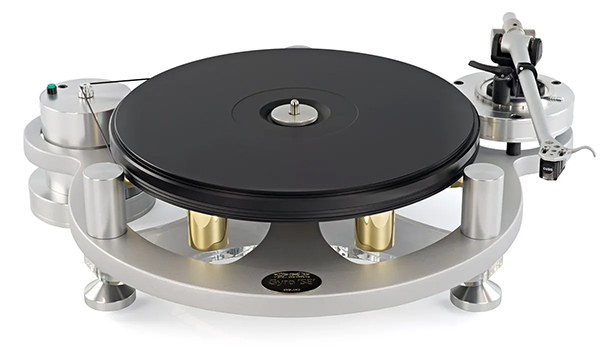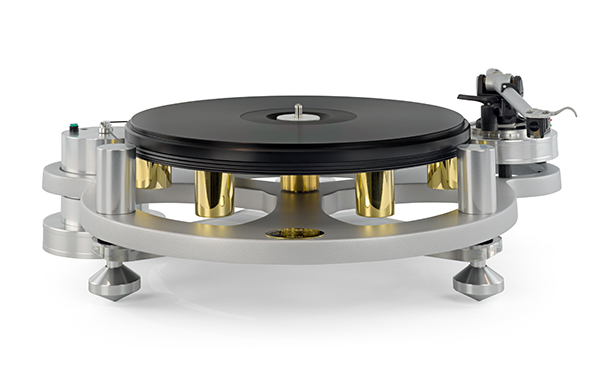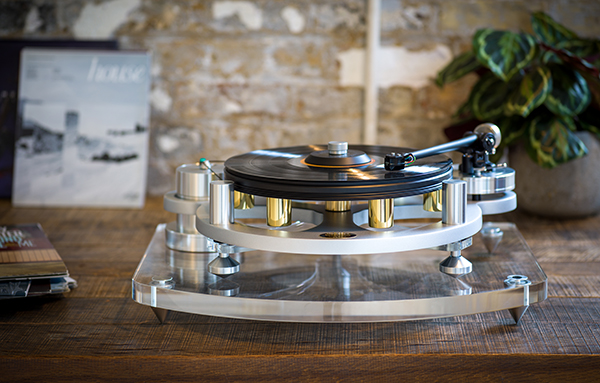Still one of audio's most beautiful designs ever. I regret not buying one when I had a choice. Opted for the Linn LP12 which is a musical money pit.
Michell Gyro SE Turntable

For the love of music. It’s a statement of purpose we can all identify with — and it also happens to be the tagline for Michell, the iconic UK audio brand founded back in the mid-1960s long known for their high-quality reference turntables, tonearms, cartridges, and accessories. Of late, we’ve been enamored with the rebranded and duly updated Michell Gyro SE turntable — which, we might add, can be properly paired with the company’s TecnoArm 2 tonearm.
First, some company history. In the mid-1960s, John Michell founded Michell Engineering to initially make parts for other turntable companies and manufacturers of the era, though the company soon enough began making its own ’tables. Michell also met legendary director Stanley Kubrick and built the spaceship Discovery for the groundbreaking 1968 science-fiction film 2001: Space Odyssey, later to become the inspiration for the company’s GyroDec turntable. If you also know anything about Transcriptors, the well-revered “By J.A. Michell Eng. Ltd.” name badge, and the Michell Reference Electronic and Hydraulic turntables, then you’re already quite cognizant of Michell products and the company’s design philosophy.

In the early 1980s, Michell came up with the following idea for the aforementioned GyroDec, as recounted on the company’s official site: “With the goal of isolating the sensitive parts of the turntable from sources of vibration and mechanical noise, John designed a suspended turntable with a floating pendulum sub-chassis and an ingenious oil-pumping inverted main bearing.” From there, Michell the company continued to flourish. Although Michell himself sadly passed away in October 2003, the company carries on under his family’s direction, bigger and better than ever.
Flash-forward to the present day, and the turntable we have here at hand: The revamped Michell Gyro SE. Initially introduced back in 1999, the SE has long been considered as a smaller footprint variation on the GyroDec. The GyroDec’s full-size acrylic plinth has instead been replaced on the SE by a “rigid and inert” (their words) acrylic spider in order to support the chassis. Furthermore, the company confirms the SE is Michell’s best-selling turntable, which may indeed lead us to reviewing one of the current versions of it ourselves in the not-so-distant future.

The features and specs for the Michell Gyro SE are these. Three suspension towers are fixed to the acrylic base of the SE in order to hold the suspension springs in place, and provide height adjustment for the sub-chassis. The platter material was chosen for its vibration-dampening characteristics. Brass weights have been added to give the platter extra mass and, subsequently, more momentum when spinning. It is also said to help keep wow-and-flutter to a minimum.
The free-standing motor unit that drives the turntable is completely separate to the turntable, with the only connection between the motor and the ’table being the drive belt. The weighted, pendulum-style sub-chassis hangs on those three above-noted suspension springs — said to provide a rigid, dense platform to mount the main bearing, platter, and tonearm assembly to ensure no movement between them, while also acting as a resonance/vibration sink to draw away unwanted vibrations from the more sensitive elements of the turntable.

The SE’s main bearing has its point of rotation at the top of the assembly, not at the bottom as many other ’tables do. This orientation allows full lubrication of the inside of the entire bearing while the platter is turning. Michell achieves this by way of a modified Archimedean screw, machined into the inside bore of the bearing. The oil is drawn from a reservoir at the base of the main bearing up to the thrust ball at the top, fully lubricating as it goes. It then returns to the reservoir via a waste hole drilled into the bearing spindle, all of it with the goal of avoiding any potential noise or vibration created by the rotation of the platter.
Finally, the SE’s solid aluminium feet are shaped so the area in contact with the supporting surface is said to be very small, in order to minimize the transfer of vibrations from the supporting furniture into the turntable.

The Gyro SE, which is available in both black and silver options, weighs 10kg, and boasts dimensions of 49 x 13.5 x 37.5cm (w/h/d). On its own, the Gyro SE has an SRP of $3,999. With the recommended TecnoArm 2 tonearm included, the SRP is $5,498. The TecnoArm 2 itself sports an SRP of $1,499.
For more about Michell, go here.
To find a Michell distributor near you, go here.

- Log in or register to post comments


Great sounding, and very arm friendly.
They also have a great price point!

... the SME Model 6 Turntable with M2-9 Tonearm, whose price has dropped from $9K down to $6K?
https://www.musicdirect.com/equipment/turntables/sme-model-6-turntable-w...
https://www.stereophile.com/content/analog-corner-309-sme-model-6-turnta...

Hi.
Don't hold yr breath yet for $6K SME TT+arm !
A used SME 3009R static balanced curve black arm, no longer made by SME any more, is now on auction at eBay today starting US$2,000 !!
Sooo expensive for such vintage arm ! I got one installed onto my DD TT for ages & I am not that fond of playing it !
Jack L

In my view an LP12 is only a money pit if you want it to be. I've owned three (long story) and found that once they're set up properly you can enjoy 'em for years. Of course Linn will sell you all the upgrades you can afford, but you can always say no.
Yes the GyroDec is good looking and works with a variety of arms (the Rega-based one in the photo is quite good) but if you do buy one please get a qualified person to set it up for the first time. Trust me on this.
Lastly, SME doesn't make any bad or even mediocre products. I hadn't realized that the model 6 was now only $6K. Goodness gracious.

It is a thing of beauty and so striking in the flesh. I nearly bought one several years ago. It had a great soundstage but was a little noisy with surface noise. Perhaps it was the cartridge, or the overhang, or VTA was off.
I remember speaking to a well-known reviewer at the Montreal Audio Show who told me that the springs resonated a little too much and were clearly audible. They said they mentioned it to Mr. Mitchell, but I don't know if anything was done. An aftermarket upgrade called the Solidair Audio Pylons sorts that issue out.
In the end, I opted for an LP12 and have since built one from parts, and I am in the process (time permitting) of making two more with parts that I purchase. You can't do that with any other table, and that's the beauty of the LP12. With two thousand dollars, you can find a gently used one and have instant access to the world of high-end vinyl replay. I have several other high-end turntables, and sometimes they are better, but overall the differences are sideways and not great leaps ahead. You can also experiment by removing the springs for elastometers or TD-124 Audio Silente rubber bushings and have a Linn LP-12 similar to a Roksan with its non-spring suspended isolation. In short, I love the LP-12, offers so much for so little money. BTW, I so enjoyed Herb's review of the LP-12, and have read it several times.

Did you replace your springs with rubber at some point and was it a noticeable improvement? I'm not sure I'd actually try it but I'm curious to hear from someone who did.
Thanks.

Yes, I did it on one of them; it makes a difference. I used the Analog Innovation elastometers, it's a breeze and sharpens the sound. The problem with tables like the Gyro and LP12 and any other suspended sprung table is that the sound is a little soft; you notice it more with pricier cartridges. I plan to do it again on two other builds I am working on, but I could easily live with the comfy sound the sprung LP-12 offers; they do an excellent job of masking surface noise.

Hi
Yes, all roads lead to Rome !
That said, my Thorens 125II vintage "suspended sprung table", sounds superb sharp & analytical even with my cheapie MM cartridge.
The tweak I have done to it: The TT are supported at its feet by 4 alloyed acoustical tiptoes, which in turn 'float" on home-made dense rubber pads , resting on a home-made stand-alone stand with its base built with 2 massy concrete hollow blocks, seated on my house wall-to-wall carpeted basement concrete floor via metal spikes. My huge cost saving DIYed baby!
Heavy MASS + isolation = closer to live performance with razor-sharp imaging.
TT, being a spinning machine, should be placed on its dedicated stand-alone stand for best music performance, IMO.
My other direct-driven TT/SME curved carbon-fibre arm/MC cartridge is also placed on its own stand-alone stand.
Both TTs come with detachable dust cover which is always removed before spinning.
Jack L

Hi
Any modification on any audio always "makes a difference" sonically.
The bottom line is: does such sonic "difference" improve the sound of the whole sound system?
Replacing the TT factory design/built spring-suspension with elastometers or whatever hi-tech suspension materials surely changes the sound, but does it also change the sonic SIGNATURE of the original TT ?????
Personally, I would not want my TT or other audio gear sound so different from its original signature sound like something else.
Even replacing the factory TT platter mat with a mat of other make can substantially alter the sound of the TT for better or worse.
So...
Jack L

Your description, "sharpens the sound" is kinda what I heard when I first installed a Lingo many years ago, and when I swapped to a Funk arm more recently. And the apparent reduction in surface noise vis-a-vis other tables is one of the things which keeps the Linn in my living room.
I looked up the elastomers - they're cheap enough that I may try 'em out and just go back if I don't like the results.

Provided you have the Linn top plate you can go ahead and use the elastometers. If you have a Tangerine or Tiger Paw top plate it becomes a little tougher, you'll need spacers which are tougher to acquire. Give it a shot, if you can, it's always fun to fettle with the LP-12.




















































